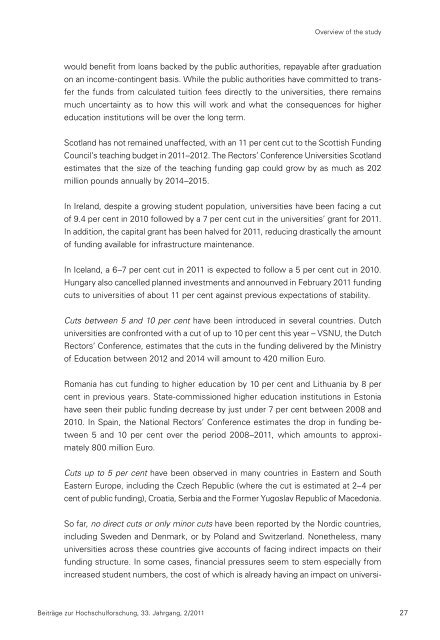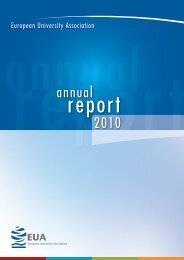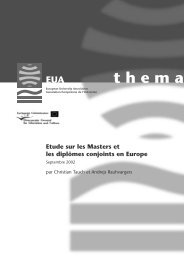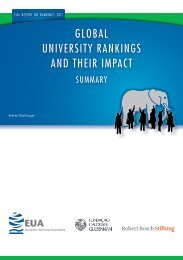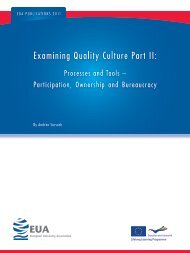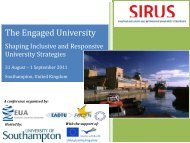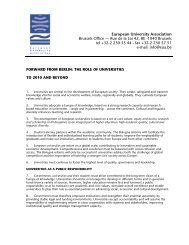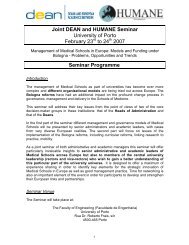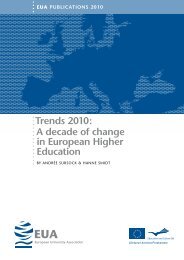Beiträge zur Hochschulforschung - European University Association
Beiträge zur Hochschulforschung - European University Association
Beiträge zur Hochschulforschung - European University Association
Create successful ePaper yourself
Turn your PDF publications into a flip-book with our unique Google optimized e-Paper software.
Overview of the study<br />
would benefit from loans backed by the public authorities, repayable after graduation<br />
on an income-contingent basis. While the public authorities have committed to trans-<br />
fer the funds from calculated tuition fees directly to the universities, there remains<br />
much uncertainty as to how this will work and what the consequences for higher<br />
education institutions will be over the long term.<br />
Scotland has not remained unaffected, with an 11 per cent cut to the Scottish Funding<br />
Council’s teaching budget in 2011–2012. The Rectors’ Conference Universities Scotland<br />
estimates that the size of the teaching funding gap could grow by as much as 202<br />
million pounds annually by 2014–2015.<br />
In Ireland, despite a growing student population, universities have been facing a cut<br />
of 9.4 per cent in 2010 followed by a 7 per cent cut in the universities’ grant for 2011.<br />
In addition, the capital grant has been halved for 2011, reducing drastically the amount<br />
of funding available for infrastructure maintenance.<br />
In Iceland, a 6–7 per cent cut in 2011 is expected to follow a 5 per cent cut in 2010.<br />
Hungary also cancelled planned investments and announved in February 2011 funding<br />
cuts to universities of about 11 per cent against previous expectations of stability.<br />
Cuts between 5 and 10 per cent have been introduced in several countries. Dutch<br />
universities are confronted with a cut of up to 10 per cent this year – VSNU, the Dutch<br />
Rectors’ Conference, estimates that the cuts in the funding delivered by the Ministry<br />
of Education between 2012 and 2014 will amount to 420 million Euro.<br />
Romania has cut funding to higher education by 10 per cent and Lithuania by 8 per<br />
cent in previous years. State-commissioned higher education institutions in Estonia<br />
have seen their public funding decrease by just under 7 per cent between 2008 and<br />
2010. In Spain, the National Rectors’ Conference estimates the drop in funding be-<br />
tween 5 and 10 per cent over the period 2008–2011, which amounts to approxi-<br />
mately 800 million Euro.<br />
Cuts up to 5 per cent have been observed in many countries in Eastern and South<br />
Eastern Europe, including the Czech Republic (where the cut is estimated at 2–4 per<br />
cent of public funding), Croatia, Serbia and the Former Yugoslav Republic of Macedonia.<br />
So far, no direct cuts or only minor cuts have been reported by the Nordic countries,<br />
including Sweden and Denmark, or by Poland and Switzerland. Nonetheless, many<br />
universities across these countries give accounts of facing indirect impacts on their<br />
funding structure. In some cases, financial pressures seem to stem especially from<br />
increased student numbers, the cost of which is already having an impact on universi-<br />
<strong>Beiträge</strong> <strong>zur</strong> <strong>Hochschulforschung</strong>, 33. Jahrgang, 2/2011 27


